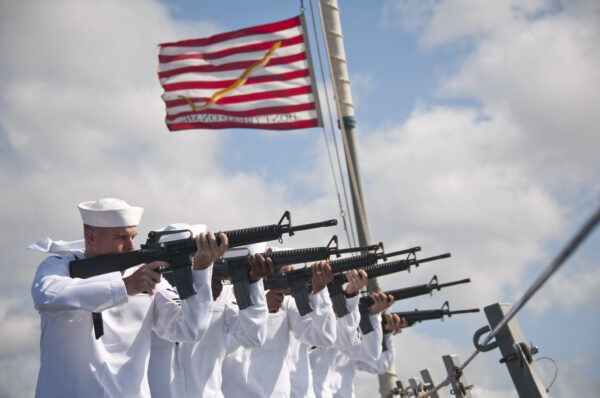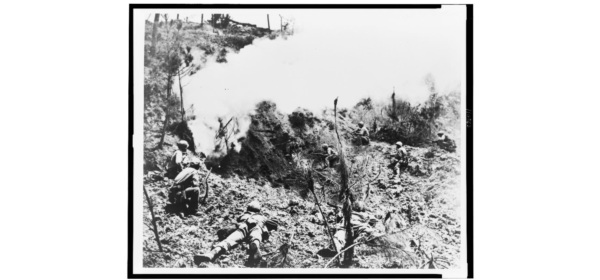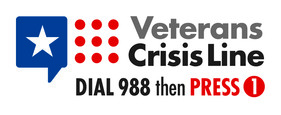
U.S. Sailors honoring naval losses suffered on April 14, 1945 during the Battle of Okinawa. (Photo: U.S. Navy)
The Battle of Okinawa was the bloodiest conflict U.S. forces fought in World War II. The last stop before Japan, the United States viewed Okinawa as the perfect staging ground for an invasion that would ultimately never occur.
Prelude to the Battle of Okinawa
Dec. 7, 1941: The Pacific War Begins With Japan’s Attack on Pearl Harbor
The Japanese Attack on Pearl Harbor forced the United States into a war it was not ready to fight. The first six months saw a string of American defeats at the hands of an Imperial Japanese military battle-hardened by a decade of fighting in the Pacific.
However, the Attack on Pearl Harbor ultimately failed to be the decisive blow to morale and the United States’ capabilities that the Japanese leaders hoped it would be. Morale in the United States remained much higher than the Japanese anticipated, and domestic industrial capacity proved especially resilient in war time. Still, the first six months of the war would see Japan continue its conquest of the Pacific.
June 4, 1942: The U.S. Turns the Tide at the Battle of Midway
After a string of defeats, the U.S. Military was reeling and public morale was plummeting. Combat-wise, the United States’ lone bright spot was a stalemate fought at the Battle of the Coral Sea, which saw both sides take significant losses. Hoping for a knockout blow, the Battle of Midway was meant to be the death blow Pearl Harbor was supposed to be.
Instead, U.S. forces inflicted a stunning defeat that would completely reverse the momentum of the war and Japan’s navy would never recover. After the victory, the United States adopted an island-hopping strategy of reclaiming lost territory in the Pacific. From the Battle of Guadalcanal to the Battle of Iwo Jima, U.S. and Allied forces continued to push back on Imperial Japan, and by early 1945, Japan was preparing for a seemingly inevitable invasion of its home islands.
The Final Battle: April 1, 1945–June 22, 1945
The Battle for Okinawa begins
Allied commanders expected the amphibious landings on the northern beaches of Okinawa to be a bloodbath. However, they didn’t encounter any resistance for the first few days of the battle. Marines and soldiers of the U.S. 10th Army were able to quickly secure two key airfields before finally facing enemy resistance on the Motobu Peninsula, about 20 miles from the initial landing points. Though the skirmish was costly, it allowed the United States to control much of the northern part of the island while finally confronting the bulk of Japanese forces concentrated within the Japanese defensive perimeter, the Shuri line.
On April 7, Imperial Japan’s last remaining major naval asset, the battleship Yamato, was sent to beach itself on Okinawan shores to act as ground-based artillery. The plan never got off the ground, though: U.S. submarine forces almost immediately spotted the Yamato’s approach and a nearby carrier fleet was able to destroy the ship and its sizable escort before it ever reached Okinawa.
Had the plan worked, U.S. forces attempting to break through the Shuri line may have been completely destroyed. Instead, American forces put an extreme amount of pressure on the defensive line through some of the Pacific War’s worst conditions. Torrential downpours and constant artillery barrages prevented the removal of bodies while Japanese holdouts alternated between nighttime assaults and the relative safety of inground bunkers.
After some of the fiercest fighting of the war, the Shuri line was broken in late May, forcing the remainder of the Imperial Japanese Army to retreat to the southern tip of Okinawa. Over a period of two weeks, most of the remaining Japanese force either fought to the death or committed suicide.

U.S. Marines attempt to smoke out Japanese soldiers hiding in a bunker somewhere along the Shure defensive line during the Battle of Okinawa. (Photo: U.S. Library of Congress)
The Naval Battle
The naval battle surrounding Okinawa began as quietly as the ground campaign, but on April 4, the first wave of Kamikaze attacks struck the U.S. Fifth fleet. Despite an overwhelming numerical advantage, the U.S. Navy was poorly equipped to defend itself from the hundreds of suicide bombers launched from nearby Japanese-controlled islands.
Despite the constant attacks, the U.S. Navy never lost naval supremacy. However, by the end of the battle, the U.S. Navy suffered nearly 10,000 casualties and lost close to 800 aircraft and 40 support ships.
Legacy of the Battle of Okinawa
The Battle of Okinawa lasted 81 days and resulted in massive casualties on all sides. The United States suffered nearly 50,000 total casualties while an estimated 110,000 Japanese soldiers were killed. The local Okinawan population suffered immensely, with some estimates suggesting as much as half of the population of 300,000 were killed due to starvation, indiscriminate fire, by suicide, or as human shields at the coercion of Japanese soldiers.
Ultimately, the importance of the battle is debated by historians. The capture of Okinawa was meant to serve as a staging area for an invasion of the Japanese mainland that ultimately never occurred, but the battle proved far costlier than expected. Wary of further American lives lost, President Harry Truman changed the course of the 20th century by ordering the atomic bombings of Hiroshima and Nagasaki. Losing on all fronts, and facing the prospects of more cities lost, Imperial Japan surrendered unconditionally, ending World War II.
To learn about more U.S. Military and veterans holidays, click here.













I grew up watching “Victory at Sea” with my father on Friday pm.